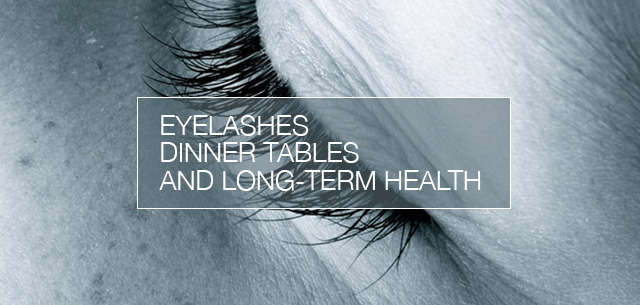Have you ever wondered why we have eyelashes?
This morning, while making coffee, I poured boiling water into our french press and it splashed a little in an unexpected way. A fraction of a second later my eyelid batted away a drop of boiling water that’d somehow missed my glasses.
Think about that. When you blink, the duration of that blink is 100 to 400 milliseconds. (.1 to .4 seconds) But, according to researchers at MIT, the human brain can recognize an image in just 13 milliseconds. That means that, instinctively [and without caffeine] my eye saw an incoming droplet within flying at my eye, my brain saw this and processed “BLINK” all within a tenth of a second.
This happened so fast and was so effective that I didn’t really think about it until AFTER it actually happened.
But is that the reason we have eyelashes in the first place? Preventing tiny boiling drops of water from hitting your eye? Partially. It turns out that our eyelashes do that… but it’s among their purposes.
Through anatomical measurements, we find that 22 species of mammals possess eyelashes of a length one-third the eye width. Wind tunnel experiments confirm that this optimal eyelash length reduces both deposition of airborne particles and evaporation of the tear film by a factor of two. Using scaling theory, we find this optimum arises because of the incoming flow’s interactions with both the eye and eyelashes. Short eyelashes create a stagnation zone above the ocular surface that thickens the boundary layer, causing shear stress to decrease with increasing eyelash length. Long eyelashes channel flow towards the ocular surface, causing shear stress to increase with increasing eyelash length. These competing effects result in a minimum shear stress for intermediate eyelash lengths.
Basically, your eyelashes exist to bat away tiny boiling drops of water but also help keep your the air around your eye moving, helping to keep the perfect moisture on all your eyes parts so that it operates optimally. Eyelashes too long? That causes fatigue. Eyelashes too short? You may experience dryness.
The Dinner Table
I think I’ve shared before that our family got our first dining room table last year. We transitioned from a family who rarely ate together to a family that regularly ate together around a family table. [Generally, we’d go to the kitchen to retreive food the go back to whatever we were doing. So we were together in the same room, just not paying attention to one another. Now we set the table, food is brought to the table, and we all sit there, eating together until everyone is finished.]
The dinner table had an instant impact on our family. Our 11 year old, who when we brought the table home said, “That’s the worst idea you’ve ever had!” has been the biggest benefactor. While we all look forward to dinner together, it’s the one guaranteed distraction free time during the day where we’re together, Paul benefits from this the most.
Since we started eating together I’ve started to recognize the family meal as a keystone behavior to our family’s health… this one thing lead to so many other good things! When we sit down together, good things happened. When we have a string of days it doesn’t happen, things begin to break down and old habits emerge.
As we started experiencing this simple, yet powerful transformation, I started to notice all sorts of research coming out ascribing family meals other indicators of mental and physical health. (Obesity, depression, drug use, etc.) In short, the dinner table started to feel like a magic bullet when I know it’s not that simple. That’s why I was excited to read this study from Cornell University, which brought balance, understanding, and context to some of the other research emerging:
The take away message from this study is that youth who engage in more frequent family meals tend to have lower depressive symptoms. While a more basic analysis suggested that family meals have a significant beneficial effect on child mental health, substance use, and delinquency, after accounting for demographic backgrounds and family relationships, these benefits decreased in magnitude, suggesting that they were not due to the family meals per se, but rather reflected the type of people who engage in family meals.
In other words, family meals are not a magic bullet. But family meals do reflect a value we, as a family, seek to be.
Ordinary Things, Extraordinary Impact
Eyelashes and Dinner Tables. Two things so ordinary that most don’t even pay attention to them until they are gone.
But without them? The long-term impact is dramatic.
We live in a society that is infatuated with extremes. Extremes get attention whereas the ordinary is ignored.
But if you ignore the ordinary? You’re missing your opportunity for long-term health.

Leave a Reply